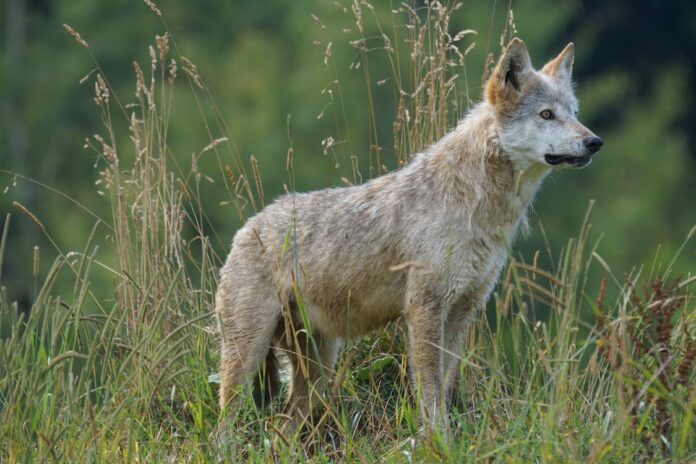By Laura D. Gelfand, Professor of Art History at Utah State University
Fairy tales are meant to impart lessons about morality, but they are not trustworthy sources of information about the natural world. Yet, most of us learn what little we know about wolves from sources as untrustworthy as fairy tales, and thus we believe things about them that are untrue. Few of us will ever encounter a wolf in the wild, so it is unlikely that we will experience the truth that comes from direct observation of an animal. That’s why, when it comes to wolves, it is particularly important to consider why we believe what we believe about them, and if our beliefs come from sources we should trust. For centuries wolves have functioned as a metaphor for evil in almost every western culture. Most of us toss off sayings like, “lone wolf,” “the wolf at the door,” “hungry as a wolf,” and “thrown to the wolves,” without seeing, hearing, or considering the wolf trapped inside these phrases. Yet, sayings like these are more than metaphorical shorthand; they reinforce misconceptions about wolves that are deeply embedded in our subconscious and they have real-world consequences for wolves. When speaking about wolves with a class of university students last semester, one of them expressed surprise to hear me say positive things about wolves claiming that they had never heard a good word about wolves, ever. Several of the student’s classmates nodded in agreement.
As an art historian, I have been thinking about representations of wolves and dogs for over a decade.[i] This is more than just a scholarly pursuit, I have a personal interest in canids. I live in Utah, a state where wolves were extirpated around 1900 after centuries of ruthless slaughter.[ii] Yet, even though no established wolf packs have lived in Utah for over a century, negative ideas about wolves are still so deeply ingrained that in response to a 2020 ballot initiative to reintroduce wolves in the neighboring state of Colorado (which passed), the Utah State Legislature passed a constitutional amendment outlawing the introduction of wolves into the state.[iii] The amendment “calls upon governmental entities to block efforts to force wolves on Utah,” yet no one had proposed reintroducing wolves.[iv] This irrational legislation was not based on trustworthy scientific studies, rather it was sponsored by lawmakers who were primarily interested in placating hunters. However, it is well established that wolves play an essential role in maintaining healthy and balanced ecosystems and they are elemental in setting the trophic cascade in motion. The trophic cascade is a phenomenon in which the introduction or elimination of a top predator has dramatic reciprocal repercussions on the entirety of an ecosystem.[v] One of the best examples of this can be seen in Yellowstone National Park, where the reintroduction of wolves changed the way that deer consume vegetation. Wolves altered the movements and habits of the deer which helped restore overgrazed riparian areas of the park and resulted in improving the health of the entire YNP ecosystem.
As the tropic cascade reveals, eliminating top predators doesn’t just affect targeted species, it also effects humans, non-human animals, and the landscape we inhabit. Currently, each winter evening dozens of mule deer walk through my backyard, eating birdseed, conifer needles, and whatever else they can find. With few natural predators, the deer population has skyrocketed and they seek sustenance in suburban neighborhoods where all too often they are chased by kids and dogs, killed by cars, and experience other forms of trauma and death. One way to begin to return to something more closely approximating natural balance is to encourage people to question what they think they know about wolves, to stop trusting fairy tales and myths, and learn how wolves function as a keystone species that is essential for many other species—including humans—to prosper.[vi] If wolves were brought back to Utah, they would pick off the weakest deer and improve the overall health of herds that are currently suffering from Chronic Wasting Disease and malnutrition due to overpopulation.[vii]
Which brings me back to the question of trust. How do we convince people that their beliefs about wolves come from sources that should not be trusted, and how do we get people to trust that wolves are essential to healthy ecosystems? As I have written elsewhere, although it is not possible to know exactly when the negative PR blitz against wolves began, I believe that it may be connected to the first humans to live with domesticated dogs; these people really needed to tell the dog from the wolf.[viii] As the physical appearance of dogs changed over time and they became our trusted companions and best friends, Western cultures started representing wolves as their opposite,[ix] they were recast as our worst enemies and made to embody what we find most terrifying. Ruthlessness, greed, and violence—all human characteristics—became ubiquitous descriptors for wolves in order to establish the most extreme possible contrast with our loyal and useful dogs. Thanks to their common genetic makeup and selective breeding it can be difficult to tell some dog breeds from wolves. This was recently illustrated when a woman shot an abandoned husky puppy, skinned it, and posted the gory results on social media, bragging that she had “smoked a wolf pup.”[x] The case was sensational enough to garner significant media attention, much of it critical, but not primarily because the hunter had killed what she thought was a wolf pup that represented no threat to her. Instead of focusing on the brutality of the woman’s actions, conservative media outlets emphasized the gender of the hunter and ridiculed her incompetence.[xi] Such sexist coverage diverted attention from the real story, that this woman believed she was killing an endangered animal and she expected others to share her excitement.
Humans have made a scapegoat of the wolf. Like Jews, the Roma, and other human “outsiders,” the wolf has been cast in the role of villain and victim. Untrustworthy sources have shaped perceptions of an essential native species, transforming it into an unwelcome interloper that unites people through the terrible power of shared hatred.[xii] Love them or hate them, wolves are highly politicized in the U.S., and those who feel strongly about them fall into opposing camps along conservative and liberal lines. Continuing to describe the wolf as big and bad and regularly using terms like “lone wolf” to describe violent human actors contributes to the threat of extinction that wolves face. The loss of the wolf would be more than the loss of a keystone species. As Angela Carter wrote, “There is a vast melancholy in the canticles of the wolves, melancholy infinite as the forest…”.[xiii] To lose the wolf would mean losing the wild and the wilderness that the wolf both creates and embodies. Instead of trusting fairy tales we need to trust science and recognize that our own future as a species is inextricably intertwined with that of the wolf.
[i] Laura D. Gelfand (ed), Our Dogs, Our Selves: Dogs in Medieval and Early Modern Art, Literature and Society, Brill, 2016; and Laura D. Gelfand, “The Wolf at the Door and the Dog at Our Feet,” Home Cultures, 18:2, (2021); pp. 105-127, DOI: 10.1080/17406315.2021.1963608.
[ii] Adam T. Switalski; Simmons, Trey; Duncan, Shiree L.; Chavez, Andreas S.; and Schmidt, Robert H, (2002) “Wolves in Utah: An introduction,” Natural Resources and Environmental Issues: Vol. 10 , Article 2. Available at: https://digitalcommons.usu.edu/nrei/vol10/iss1/2
[iii] The text of the bill can be read here: https://le.utah.gov/~2020/bills/static/HCR019.html. It was signed into law in March, 2020.
[iv] The bill states: BE IT FURTHER RESOLVED that the Legislature and Governor call upon the President of the United States, the United States Department of the Interior, and Congress, to block efforts to force wolves on the state of Utah to preserve the historical and conservation values of Utah, its wildlife, its family ranchers, its economy, its outdoor heritage, and its citizens. https://le.utah.gov/~2020/bills/static/HCR019.html.
[v] William J. Ripple, Robert L. Beschta, Luke E. Painter, “Trophic cascades from wolves to alders in Yellowstone,” Forest Ecology and Management, Vol. 354, 2015, Pages 254-260, ISSN 0378-1127, https://doi.org/10.1016/j.foreco.2015.06.007.
[vi] Adam T. Switalski; Simmons, Trey; Duncan, Shiree L.; Chavez, Andreas S.; and Schmidt, Robert H. (2002) “Current public attitudes toward wolves in Utah,” Natural Resources and Environmental Issues: Vol. 10 , Article 4. Available at: https://digitalcommons.usu.edu/nrei/vol10/iss1/4.
[vii] https://wildlife.utah.gov/chronic-wasting-disease.html
[viii] Laura D. Gelfand, “The Wolf at the Door and the Dog at Our Feet,” Home Cultures, 18:2, (2021); pp. 105-127, DOI: 10.1080/17406315.2021.1963608. It is not known where or when the first gray wolves were domesticated and gave rise to dogs, but modern dogs and wolves share over 99% of their DNA ancestry. See A. Bergström, Stanton, D.W.G., Taron, U.H. et al. “Grey wolf genomic history reveals a dual ancestry of dogs.” Nature 607, 313–320 (2022). https://doi.org/10.1038/s41586-022-04824-9.
[ix] I want to emphasize that this is a problem specific to western culture, indigenous cultures in the U.S. understood and still recognize the essential importance of the wolf in nature.
[x] Aaron Bolton, “A Montana woman bragged about killing a wolf pup. It was actually a husky.” NPR: All Things Considered, September 28, 2022. https://www.npr.org/2022/09/28/1125747319/a-montana-woman-bragged-about-killing-a-wolf-pup-it-was-actually-a-husky, and Amanda Wight, “She mistook a dog for a wolf—and fired,” Salt Lake Tribune, October 22, 2022. https://www.sltrib.com/opinion/commentary/2022/10/11/amanda-wight-she-mistook-dog/
[xi] Yaron Steinbuch, “Montana woman kills skins husky after mistaking it for wolf,” New York Post, Sept. 27, 2022; https://nypost.com/2022/09/27/montana-woman-kills-skins-husky-after-mistaking-it-for-wolf/; Rebecca Rosenberg, “ Montana woman shoots, skins Siberian husky she mistook for a wolf,” Fox News, Sept. 27, 2022, https://www.foxnews.com/us/montana-woman-shoots-skins-siberian-husky-mistook-wolf.
[xii] See René Girard, The Scapegoat, trans. Yvonne Freccero, (1989) Johns Hopkins University Press.
[xiii] Angela Carter, The Bloody Chamber and Other Stories, (1979) Vintage Classics, p. 188.
Laura D. Gelfand is Professor of Art History at Utah State University. Her research engages the vibrant, interdisciplinary world of animal studies with a particular focus on canids. She edited the volume Our Dogs, Our Selves: Dogs in Medieval and Renaissance Art, Literature, and Culture (Brill 2016). Among other awards, she was a Fulbright Fellow in the Department of the History of Art at the University of York in 2018-19 where her research centered on historical (mis)representations of wolves.





